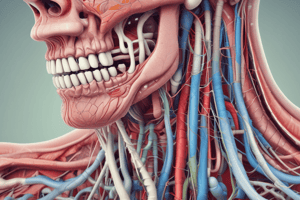Podcast
Questions and Answers
The identifiable salivary glands of the cat include the ________.
The identifiable salivary glands of the cat include the ________.
parotid gland, submandibular gland, sublingual gland, and molar gland
The __________ closes the entrance to the larynx during the act of swallowing.
The __________ closes the entrance to the larynx during the act of swallowing.
epiglottis
The __________ cover(s) the wall of the abdominopelvic cavity and the surface of the abdominopelvic organs.
The __________ cover(s) the wall of the abdominopelvic cavity and the surface of the abdominopelvic organs.
peritoneal membrane
The largest and most easily identifiable organ of the abdominal cavity is the __________.
The largest and most easily identifiable organ of the abdominal cavity is the __________.
What is the stomach?
What is the stomach?
What are the accessory digestive organs?
What are the accessory digestive organs?
The three parts of the small intestine are the ________.
The three parts of the small intestine are the ________.
The serous membrane that covers the deep surface of the abdominal body wall is the __________.
The serous membrane that covers the deep surface of the abdominal body wall is the __________.
Which mesentery listed below is a dorsal mesentery?
Which mesentery listed below is a dorsal mesentery?
The inferior mesenteric artery passes through the __________ and supplies the __________.
The inferior mesenteric artery passes through the __________ and supplies the __________.
Which organ has both a dorsal mesentery and a ventral mesentery attached to it?
Which organ has both a dorsal mesentery and a ventral mesentery attached to it?
The mesentery through which the umbilical vein passes is the __________.
The mesentery through which the umbilical vein passes is the __________.
Identify the salivary gland that lies deep to the submandibular duct.
Identify the salivary gland that lies deep to the submandibular duct.
The three structures that cross the masseter muscle from superior to inferior are the __________.
The three structures that cross the masseter muscle from superior to inferior are the __________.
Which structures are innervated by the dorsal and ventral facial nerves?
Which structures are innervated by the dorsal and ventral facial nerves?
Which muscle functions in swallowing?
Which muscle functions in swallowing?
The four muscles identified in this video all attach to the __________.
The four muscles identified in this video all attach to the __________.
The structure that is located medial to the digastric muscle is the __________.
The structure that is located medial to the digastric muscle is the __________.
The esophagus and trachea are readily identifiable due to ________.
The esophagus and trachea are readily identifiable due to ________.
A retroperitoneal organ is suspended to the body wall by a mesentery.
A retroperitoneal organ is suspended to the body wall by a mesentery.
Chemical digestion of food is completed and nutrients are absorbed in the large intestine.
Chemical digestion of food is completed and nutrients are absorbed in the large intestine.
List the accessory digestive organs.
List the accessory digestive organs.
The common bile duct and the ___________ duct merge and empty into the duodenum at the same location.
The common bile duct and the ___________ duct merge and empty into the duodenum at the same location.
Match the components of a tooth with their descriptions:
Match the components of a tooth with their descriptions:
Flashcards are hidden until you start studying
Study Notes
Salivary Glands
- Main salivary glands in cats: parotid, submandibular, sublingual, and molar glands.
- Sublingual gland is positioned deep to the submandibular duct.
Larynx and Swallowing
- The epiglottis serves to close the entrance to the larynx during swallowing.
- The mylohyoid muscle aids in swallowing by elevating the floor of the mouth.
Abdominopelvic Cavity
- The peritoneal membrane covers both the walls of the abdominopelvic cavity and the organs within it.
- Key organ: the liver, recognized as the largest organ in the abdominal cavity.
- The stomach, located on the left side and partially obscured by the liver, is a large muscular pouch.
Digestive Organs
- Accessory digestive organs: liver, gallbladder, pancreas, and their associated ducts.
- The small intestine comprises three parts: duodenum, jejunum, and ileum.
- The common bile duct unites with the pancreatic duct, emptying into the duodenum.
Mesenteries
- The parietal peritoneum lines the abdominal wall, while the visceral peritoneum covers organs.
- The greater omentum, a dorsal mesentery, connects to the greater curvature of the stomach.
- The falciform ligament carries the remnant of the umbilical vein to the liver.
Nervous Innervation
- Dorsal and ventral facial nerves innervate facial muscles and run across the masseter muscle.
- The hypoglossal nerve, located medial to the digastric muscle, controls tongue muscles.
Esophagus and Trachea
- The esophagus can be distinguished from the trachea due to the lack of cartilage in its structure.
Organ Classification
- Retroperitoneal organs are not suspended by a mesentery.
- Nutrient absorption primarily occurs in the small intestine, not the large intestine.
Tooth Structure
- Components of a tooth include crown, neck, root, enamel, dentin, pulp cavity, cementum, periodontal ligament, and root canal.
Studying That Suits You
Use AI to generate personalized quizzes and flashcards to suit your learning preferences.



